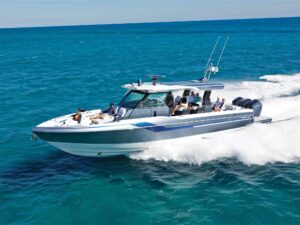Those who have outboards with unregulated charging systems along with late model electronics on their boat are probably familiar with aggravating overvoltage alarms and depth-finder shut downs. These same folks may also be familiar with having to add water to their batteries quite often or they may be upset with reduced battery life on maintenance-free or sealed batteries. Without any type of voltage regulation, excess charging current raises the battery voltage above 14.8 volts, shortening the lifespan of electrical components and electronic accessories.
Not that many years ago alternator equipped outboards were designed with low output charging systems that consisted of just the alternator windings and a set of diodes to convert the AC (alternating current) to DC (direct current) for battery charging. At that time the only power consumption from the battery was often running lights and perhaps a radio. The battery capacity was the determining factor in voltage output as the battery came up to full charge. If the voltage became too high, the boat owner either turned on the running lights or installed a larger battery which could absorb the excess current, thus lowering the voltage.
CDI Electronics of Huntsville, Alabama, has developed a unique electrical component to replace the fragile diode rectifier on older and on smaller outboards that do not have any type of voltage regulation. Besides the older style engines, some economy models such as the Johnson and Evinrude special series with horsepower ratings ending in the number 8 — 28, 48, and 88 – can easily and economically take advantage of CDI’s new technology.
CDI’s Regulated Rectifier is an answer to the long term problems of excessive unregulated voltage outputs from outboard motors that were originally equipped with only a rectifier. Housed in an aluminum case with the same bolt pattern it easily installs in place of the OEM diode assembly with two screws. Fastening the color-coded wires to the terminal board is all that remains to do. Now a boat owner will have the same safe charging voltage as a new outboard does with no more overvoltage alarms from his or hers electronics.
There are 6 models of the CDI Rectifier Regulator to fit many of the Johnson, Evinrude, Mercury, and Mariner outboards manufactured over the years going all the way back to the mid 1960’s. This component may also be used on lawn equipment and other small engines by simply bolting it in place of the OEM rectifier and connecting the wires.
The most common Johnson-Evinrude Regulated Rectifier assembly, part #193-3408, retails for about $100 which is much less than purchasing an OEM voltage regulator from an outboard dealer and modifying it to work on a motor. For more information click on CDIELECTRONICS.COM. They do not sell to the public, only through professional technicians, marine repair shops, boating supply stores, and online websites specializing in parts and accessories.
SUGGESTED READING
BOATINGLAB TESTS: THE TRUE COST OF OUTBOARD OWNERSHIP
HOW TO CHOOSE AN OUTBOARD MOTOR








